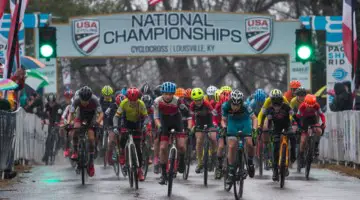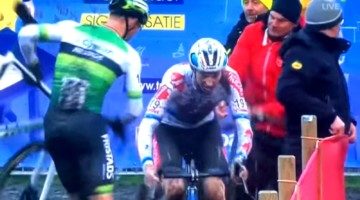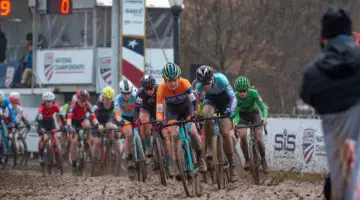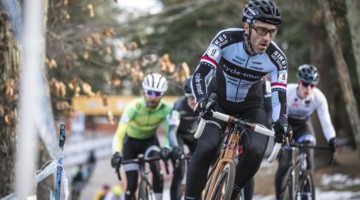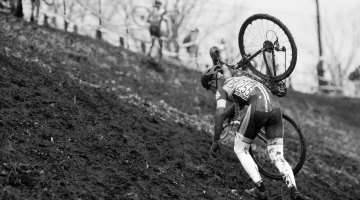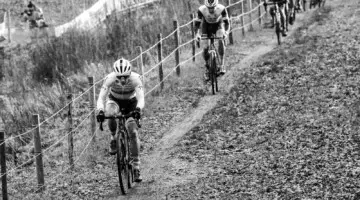Last week, Wisconsin-based Zachary Schuster penned a Wednesday Wonderings column that answered questions many West Coast cyclocrossers have about USA Cycling rankings as they head into the 2017/2018 season and towards Reno Nationals.
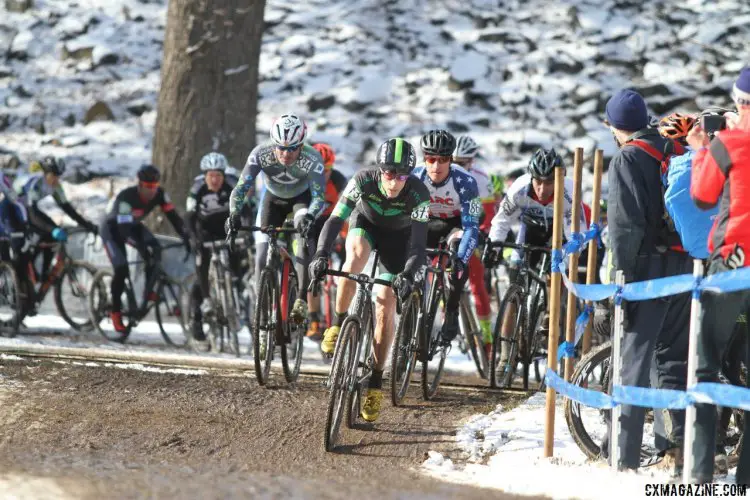
The race to the first turn at Nationals begins much earlier in the season for many. photo: 2017 Cyclocross National Championships, Masters Men 55-59. © D. Mable / Cyclocross Magazine
The article was well received, generated some discussions and chatter and did its job by piquing my curiosity. I understood the system, but how could a 600-point (worst possible), last-ranked West Coaster like me efficiently climb up the rankings so I can start a few rows up from the very back in my age group at Nationals? This is important, improving my rankings could delay the privilege of an unplanned meeting with Adam Myerson by ten seconds or more.
Don’t get me wrong. I like Adam Myerson, and he supports this publication. We’ve crossed paths many times, including at his 1991 UMass cyclocross race, the very first race he promoted. But if I’m to race my age group, my first title race in 13 Nationals I’ve attended, I’d like to avoid the defending champion for as long as possible.
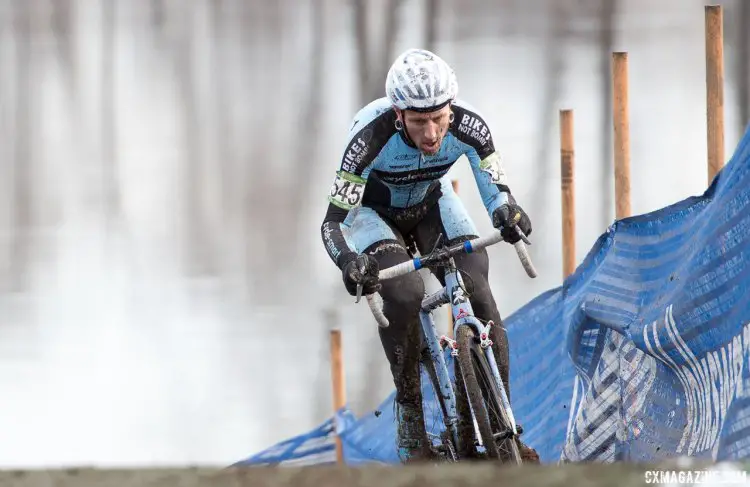
He’s crossed our lens many times, but the author is trying to avoid him in Reno. photo: Adam Myerson climbs up from the river one last time. 2017 Cyclocross National Championships, Masters Men 45-49. © A. Yee / Cyclocross Magazine
After reading Schuster’s piece last week, I had several takeaways to consider if I was going to get serious about improving upon my not-so-perfect 600 point ranking:
- Race quality matters
- Field size doesn’t matter
- Without pre-registration or published start lists, and without the budget to travel to bigger races, it’s really hard to pick the best category to race in order to earn maximum points (a lower score).
- Racing against others in the same boat as me helps no one.
Pick Your Battle
Armed with results from just one early-season Central Coast Cyclocross series race (the only USAC option around for many of us in Northern California), I looked at all the B and A-category race results and attempted to figure out my best chances for efficiently climbing up the rankings as fast as my slow legs and strategic planning would allow.
The beauty of Norcal racing is whether it’s USA Cycling sanctioned or not, it’s largely self-categorized. You can pretty much race any level you want, as long as your gender and age apply, and of course, just like anywhere else, Masters can always age down. The loose Norcal rules gave me a dizzying number of options, with four B race categories as well as four A race categories to choose from (Open, Singlespeed, Masters 35+ and 45+ in A and B). Nobody would have stopped me from racing Cs (except hecklers), but I also assumed there were little points to be gained by racing at that level.
I made a few safe assumptions and looked at hypothetical scenarios. I knew I couldn’t win a B race but could be competitive in Masters or singlespeed, possibly finishing somewhere between third and fifth, and a little less competitive in Open. And since almost every time I race with the Masters As I get lapped or nearly lapped, I assumed I’d be last in any A race.
After studying the tiny data sample, the conclusions surprised me. My chance for a good score depended not on the speed or depth of the field, but mostly on a few highly-ranked racers showing up. In fact, if that happened, a smaller field size would likely be better so that the points of top-level racers wouldn’t be diluted in the race quality score. If I had raced last week, my best bets were to race the B Singlespeed race and hope for top three in the small field, claim last in the Masters A 35+ race, or stay til the end of the day and race for an hour plus and get last in the Open A race.

When one or two top-ranked racers show up, it helps everyone in the points hunt. 2017 CCCX Race #1 – Central Coast Cyclocross Series Race Results

With fast competition, the Masters 35+ A race presented the second-best points grab option. 2017 CCCX Race #1 – Central Coast Cyclocross Series Race Results
If your eyes went blurry following this, take some comfort in the fact that mine did too. I’ve never been a points hunter and never played one on TV. I also know, just as with stocks, past performance can’t predict the future. But since that’s all I had, I headed to my first race of the year with a loose plan. I also held out hope that the same competitors showed up to validate my choices, and help me in a little way avoid Adam.
The Hunt Begins
Points hunting can create a strange situation where you’re wanting recent winners to not upgrade. I signed up for the B singlespeed race and hoped that last week’s winner Jason Prater, one of the top-ranked Cat 3 cyclocrossers in the state, would return in an attempt to continue his winning streak. I asked around at the start line and indeed, the man with the golden USAC ranking was there. I smiled—mostly out of friendliness—but also because there was a chance I made a smart choice.
My plan was off to a good start. Our small singlespeed field started with the Open B men, and shortly after the start, I lost track of my five competitors and had no idea where I sat. I tried to race smoothly and contain my chronic side pain, and at the end of the suffering, I crossed the finish line with the curiosity of whether it all worked out.
However, there was no time to check results and figure that out. I headed back to the car, pulled off my jersey and slapped another pre-numbered one on, all while trying to down some cold liquids. There were points to be claimed, riders to lap me, a DFL position to fill, and it was already a few minutes past my scheduled start.
Double Up to Move Up
I raced to the start for the second time that morning, and to my delight, saw that I didn’t miss my start. To my dismay, however, I saw that the last week’s top two finishers in the Masters A 35+ were nowhere to be seen. Living legend Don Myrah skipped the event, while Chris Peck (formerly a top New England racer and Cannondale employee) opted to race with the Elites in the Open A race. Shucks. Perhaps I should have listened to my (imaginary) financial advisor. The next 50 minutes of suffering seemed unlikely to have a return on the investment.
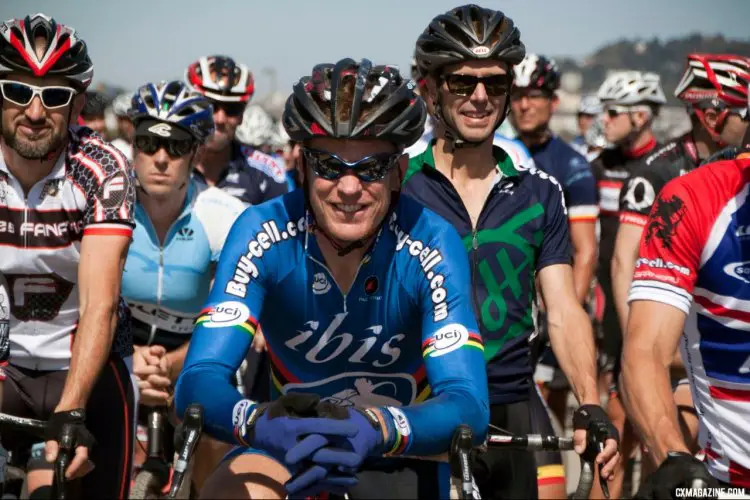
The one day the author missed seeing Myrah’s smile at the start line of his race was the day he needed him to be there. photo: Myrah shows off his World Champion stripes before his battle with the younger 35+ Masters men. Candlestick Park, 2012. ©Cyclocross Magazine
I’ll save you most the boredom of my second race, but as I predicted, I was passed by Masters A racers of every age, got lapped by most, suffered a pretty bad heat/dehydration headache just two laps and had to switch bikes twice. With my placing secure, I focused much of my attention on small victories, like trying to ride the loose run-up (one success!). I finished broken, dehydrated but finally believing that #crossishere and ready for a worker’s comp claim for being subject to such suffering, all for a dumb story.
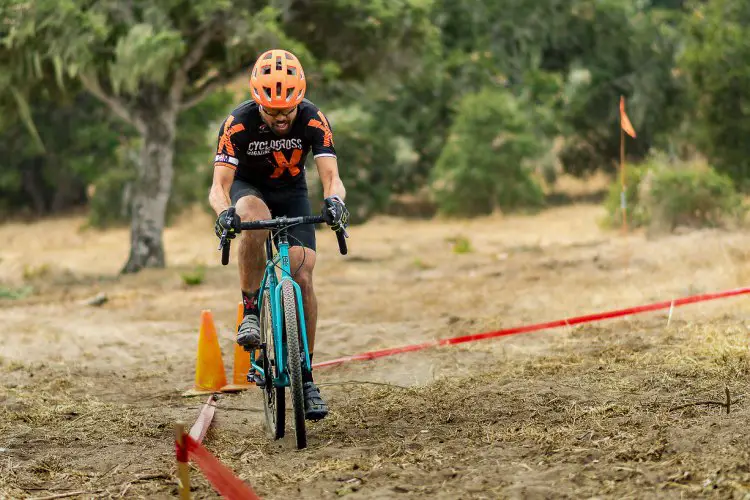
The author all alone at the back, with nothing but time to hunt points and run-up glory. photo: Jeff Vander Stucken
Wait Just a Minute
Sometimes the hardest part of an experiment is the wait. I limped home (literally, with cramps) expecting a long wait to see if this academic-turned-painfully-real test worked out. I figured no race promoter or USA Cycling official wants to upload cycling results on the eve before Labor Day. Yet much to my surprise, a late night check on USA Cycling’s website revealed the day’s results.
Did I earn front-row points? No, not quite. Yet somehow, it all worked out to plan. In the B races, I claimed 417 points with a second in the B Singlespeed race, a very modest score, but far better than what I could have claimed even if I won either Masters age groups—which wasn’t going to happen anyway—and far better than what I could have achieved in the Open B race given my lap times, even if adjusted for a geared bike. My first-ever USA Cycling points weren’t too bad, thanks to a highly-ranked winner ahead of me.

Although scores were worse than the week before (because the previous week’s second place did not race), this score was the best possible outcome. 2017 CCCX Race #2 – Central Coast Cyclocross Series Race Results
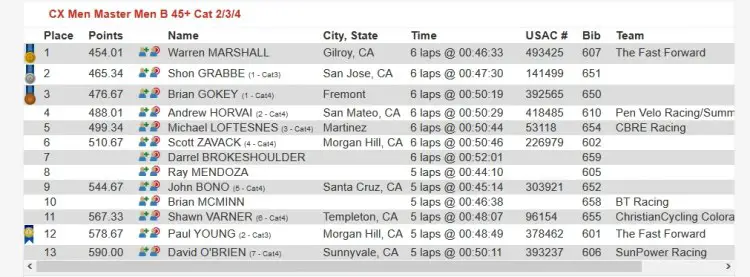
A podium in Masters B 45 is not worth as much as a top 2 in a small 6-man singlespeed B field. 2017 CCCX Race #2 – Central Coast Cyclocross Series Race Results
In the Masters A race, even without Myrah or Peck, my DFL place in the 35+ race was far better than what I would have scored if I raced the much-larger field in the Masters 45+ race. I earned a 499 score—terrible by most region’s standards—but better than the 536 score the last-placed Masters 45+ finisher claimed, and even better than the 552 score the last Singlespeed A racer earned. If I was to stay around and race the longer A race, my efforts still wouldn’t have been rewarded. The last place Open A racer scored 482. I would have been worse.

DFL and a lap down (results are incorrect), but a better score than last in other categories and an improvement over a 600. 2017 CCCX Race #2 – Central Coast Cyclocross Series Race Results
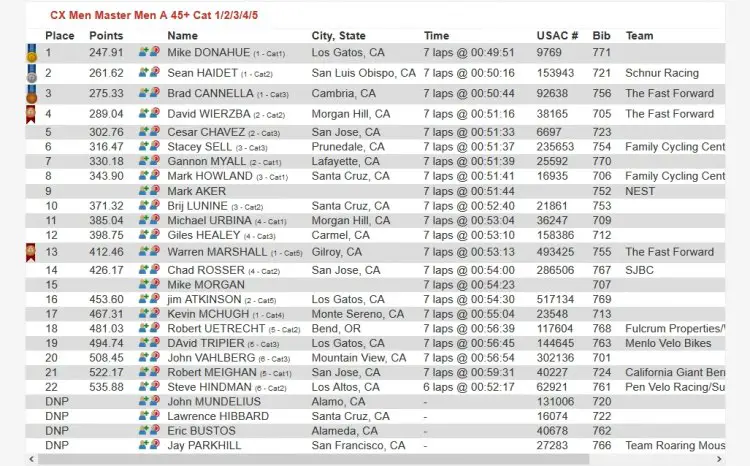
Last in a deeper Masters A 45+ field earned a worse score than last in a small Masters A 35+ field. 2017 CCCX Race #2 – Central Coast Cyclocross Series Race Results
With just two races done in one day, I’ve gone from last to halfway up the rankings for my five-year category in California. That’s some progress, even if my current score would have me at the back of Nationals. I still have three 600s to replace.
Lessons Learned While USAC Points Hunting
Double Down
Take advice from a novice hunter who has only bagged two 400+ point races at your own risk, but if you want to race Nationals and care about your start position and probably won’t make five USA Cycling events in a year, doubling up can pay off. Any result should be better than a 600 score, even last place. Check with your promoter to see what discounts are available for your second or third race. Don’t think you could do two or three races in a day? There’s no guarantee you won’t have a 50-minute mechanical in your last race, but if you keep riding and cross the line you should be a finisher and thus earn points. USA Cycling does not care if you are last by just one second or down four laps.
Feeling Old? Be in Denial
Don’t assume racing your age group or ability or choosing a deep field makes the most sense. Older Masters would often be better off racing a younger group and finishing last. All but one Masters 60+ would have earned more points finishing last in my 35+ race, even though many of are faster than me. At CCCX, a cagey points-hunting older Masters racer could register for the younger group, soft pedal for 30 seconds or line up in the wrong field and still race his peers in an attempt to get the best of both worlds.
Reevaluating Priorities
For racers with little hope of cracking the top 20 in Reno, is the convoluted points chase worth it? Like Schuster said in his Wednesday Wonderings answer, perhaps the time and energy focused on improving your starts or simply training would be a better investment.
Don’t get me wrong, I had fun suffering for this experiment. But for me, personally, trying outsmart the system all just for 45 minutes of racing in January isn’t worth the trouble. I have little chance of finishing on the same lap as the leaders in Reno even on my best day and don’t want one race to dictate how I race a whole series or season.
Most of us, myself included, are racing on the weekend for a challenge and for fun. Sometimes fun is maximized by racing against familiar foes, racers of similar age and ability. You could shun the group in an attempt to gain more points for just one day in January, but is that worth it? Having Nationals as a season-long goal is an admirable, lofty goal, but if you were to flat one minute into the race, would you regret skipping battles with your peers for your season-long points-oriented approach? Contenders probably won’t. Pack fillers like me might.
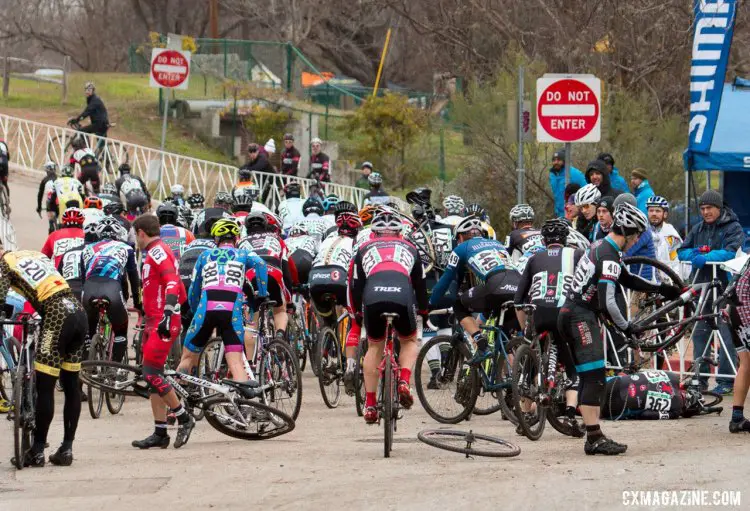
Planning a whole season around one race has its risks. photo: 2015 Nationals, start in the Masters 40-44 race. © Cyclocross Magazine
And while doubling up certainly has its training benefits, for me, it inevitably removes the one thing I crave in racing cyclocross the most: the complete focus on the task at hand.
When you know you’ve got another race ahead, it’s hard not to keep a little bit in the tank. And when in you’re in your second race, at least in my condition, the body doesn’t always respond to every command, and you’ve got an easy excuse to give less than everything. That doesn’t feel like racing.
I race for the challenge, thrill, joy and in a strange way, my own version of meditation; I don’t need the points. Other racers, like Junior Ryder Uetrecht, have true Nationals podium aspirations and limited choices. Uetrecht and his family made the long drive from Bend, Oregon to Monterey just to chase USA Cycling points. That’s an expensive trip to do one race. Is that how we want young talent to spend their time and money? I don’t have all the answers, but there might be a better way.
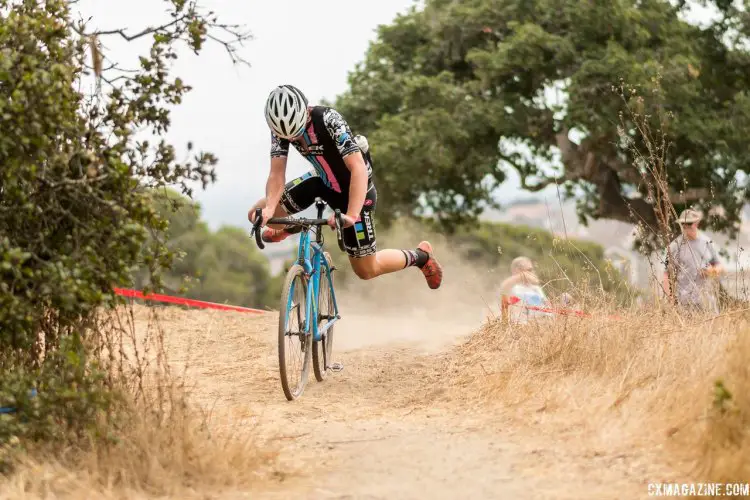
Ryder Uetrecht hopes to hop up the USA Cycling rankings with his road trip from Bend, Oregon to take points in Monterey, California. 2017 CCCX CX Race 2 © J. Vander Stucken / cxmagazine.com
My days as a points chaser lasted just one painful Sunday. Now I’m focused on a full recovery and have no plans for a relapse.
For any racer without USA Cycling points focused on a good ride in Reno, best of luck in the hunt. Three days later, I still feel your pain.
Have a question or topic you’d like us to explore (in far greater detail than you might want)? Submit it below.























